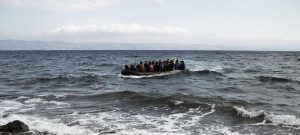By Michelle Markell
In January 2021, the United Nations Human Rights Committee (“the Committee”), an independent expert body that monitors States’ compliance with the International Covenant on Civil and Political Rights (“the Covenant”), released a decision in A.S., D.I., O.I. and G.D. v Italy, [“A.S. et al v Italy”], finding that Italy violated the right to life of more than 200 migrants when it allowed them to drown outside its territorial waters in 2013 despite having a rescue boat nearby.
The tragic facts of A.S. et al v Italy raise complex issues of jurisdiction and the extraterritorial application of international treaties, as discussed here and here. Although traditional notions of jurisdiction hold states responsible for respecting and protecting rights within their geographic boundaries, the Committee found that, in this case, individuals in international waters were subject to Italy’s jurisdiction despite being located outside its physical borders. The Committee’s jurisdictional ruling has attracted a lot of attention as it develops the Committee’s analysis in previous cases that find states may be responsible for human rights violations outside of their territory when their actions are a link in the causal chain of events leading to the violation. In A.S. et al v Italy, the Committee found this causal link due to the special relationship of dependency that was created between the people on board the sinking ship and the Italian authorities. The decision marks an important contribution to the Committee’s jurisprudence on extraterritorial jurisdiction, affirms the importance of the right to life, and is a hopeful step forward in closing the accountability gap for failure to protect migrants who flee persecution only to find themselves in situations of distress at sea.
The facts of the case
On October 11th, 2013, between 11.00 a.m. and 12.30 p.m., a fishing boat in distress carrying more than 400 migrants in the Mediterranean Sea made contact with Italian authorities. The sinking ship was located within the Maltese Search and Rescue (“SAR”) Region — 61 miles south of Lampedusa, Italy and 118 miles southwest from Malta. The people on board were told to contact Maltese authorities, but were assured by Italian authorities that they would be rescued. Evidence showed that Italy often performed or assisted with rescues in this SAR area despite it being formally within Malta’s jurisdiction.
Maltese authorities were contacted and agreed to coordinate the rescue operation after 1 p.m. However, the Maltese rescue effort was slow and ineffective. Italian authorities remained involved due to the proximity of an Italian navy ship, ITS Libra, to the sinking ship. Although located only one hour away from the ship in distress, the ITS Libra was not ordered to assist in the rescue for at least 4 hours. When the ITS Libra finally arrived on scene well after 6 p.m., it was too late. The ship had capsized and more than 200 people drowned, including 60 children.

Lampedusa, Italy. Photo: Unsplash
Why the ship was considered to be Italy’s responsibility
The Committee found that Italy and Malta both had jurisdiction over the ship. Malta had formal control of the SAR area. A similar case against Malta was nonetheless declared inadmissible due to failure to “exhaust domestic remedies” — a requirement under the Covenant.
At the same time, the Committee found that Italy also had jurisdiction because it had “power or effective control” over the ship — a finding that has garnered attention and merits further discussion. While this finding might appear entirely novel, a close examination of the Committee’s jurisprudence reveals that this case was instead simply an example of the Committee applying well-established legal principles to a new fact pattern.
The Committee’s majority decision is based on its understanding of “jurisdiction” under article 2 of the Covenant as explained in General Comment 31. Article 2(1) provides that a state is responsible for securing the rights recognized in the Covenant “to all individuals within its territory and subject to its jurisdiction”.
In General Comment 31, the Committee interpreted article 2 to mean that: “a State party must respect and ensure the rights laid down in the Covenant to anyone within the power or effective control of that State Party, even if not situated within the territory of the State Party” (para 10). Thus, already in 2004, when General Comment 31 was adopted, the Committee recognized that a state can be responsible for rights violations outside of its territory.
This understanding of jurisdiction was reinforced and elaborated on in General Comment 36, describing the right to life, which similarly says that a State must respect and ensure rights for those in its jurisdiction, which includes “all persons over whose enjoyment of the right to life it exercises power or effective control”. General Comment 36 goes on to say that States are required to protect those “who find themselves in a situation of distress at sea, in accordance with their international obligations on rescue at sea” (para 63). This General Comment has attracted commentary for adopting a “impact model” of jurisdiction, where duties to protect individual rights arise even when the individuals are outside the geographic boundaries of the territory, the more traditional “territorial jurisdiction.” The Human Rights Committee again relied on this personal model of jurisdiction when considering Italy’s failure to rescue.
Because the ship was within Malta’s SAR area, the Committee asked whether the individuals who lost their lives were within Italy’s “power or effective control”. The meaning of these concepts in Committee jurisprudence was discussed in a 2009 decision involving the Romanian embassy in Iraq, Munaf v Romania. According to this decision, a country can be held responsible for rights violations that occur outside its territory, if it is “a link in the causal chain” that makes those rights violations possible in another jurisdiction (para 14.2). The violation needs to have been a necessary and foreseeable consequence of the country’s action, taking into account the information that the country had at the time. That is to say, the Committee needs to determine the role played by the country in allowing the violation to happen, such as creating the conditions or not intervening when they could have.
Applying the principles outlined in Munaf to this case, the Committee found that Italy’s actions were “a link in the casual chain” that resulted in the loss of lives. The violation of the right to life was a necessary and foreseeable consequence of a failure to act because of “a special relationship of dependency” that had been established between Italy and the individuals in distress due to the assurances by the Italian authorities, their ongoing involvement in the rescue mission, and the close proximity of the ITS Libra to the ship in distress (para 7.8). The Committee’s analysis was bolstered by Italy’s international legal obligations under the law of the sea, which demonstrate that the law has long recognized the particular vulnerability of a ship in distress at sea and the responsibility of States to protect the right to life if it is within their power to do so.

Photo: UNICEF/Alessio Romenzi
The decision was not without controversy. It was accompanied by three dissents and four concurring opinions, representing the complexity of the issues. Four concurring opinions were authored by Ms. Hélène Tigroudja, Ms. Vasilka Sancin, Mr. José Santos-Pais and Mr. Gentian Zyberi. Ms. Tigroudja and Ms. Sancin elaborated further on the concepts of “power and effective control,” highlighting the communication between Italian authorities and the ship in distress in the first hours of the request for help. Mr. Santos-Pais emphasized that the Italian authorities did not explain their failure to provide valuable information to Maltese authorities and their deliberate withholding of assistance. Mr. Zyberi clarified States’ international legal obligations to render assistance to persons in distress at sea.
There were three dissenting opinions. The dissent co-authored by Mr. Yuval Shany, Mr. Christof Heyns and Ms. Photini Pazartzis argued that the Committee failed to distinguish between the mere potential for the victims to have been under the effective control of Italy and the State’s actual effective control, an argument which does not discuss the notion of “power” and appears at odds with the Committee’s views in Munaf and the long-recognized notion of personal and territorial jurisdiction. In their dissents, both Mr. Andreas Zimmermann and Mr. David Moore expressed concern that the uncertainty caused by the decision may hinder future rescue operations, particularly if authorities fail to rescue in order to avoid creating a ‘special relationship of dependency’. Although this is a valid concern, this tragic fact pattern of allowing migrants to drown at sea is not unique and, for years leading up to this ruling, states persistently failed to rescue migrant ships in the Mediterranean. As such, the ruling is unlikely to lead to an even greater loss of life.
Overall, A.S. et al v Italy is an important contribution on tricky issues of jurisdiction and responsibility, which develops core concepts from prior Human Rights Committee cases. It is also a hopeful step forward in closing the accountability gap and holding States accountable for preventable violations, including the loss of life at sea.
Michelle Markell is a 2L student at the Peter A. Allard School of Law working with the IJHR Clinic as part of the HRC Team.